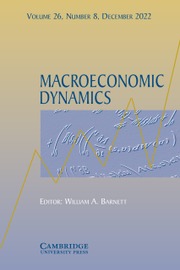No CrossRef data available.
Article contents
Robotic capital - skill complementarity
Published online by Cambridge University Press: 06 November 2024
Abstract
Relying upon an original (country-sector-year) measure of robotic capital ( $RK$), we investigate the degree of complementarity/substitutability between robots and workers at different skill levels. We employ nonparametric methods to estimate elasticity of substitution patterns between
$RK$), we investigate the degree of complementarity/substitutability between robots and workers at different skill levels. We employ nonparametric methods to estimate elasticity of substitution patterns between  $RK$ and skilled/unskilled labor over the period 1995–2009. We show that: i) on average,
$RK$ and skilled/unskilled labor over the period 1995–2009. We show that: i) on average,  $RK$ exhibits less substitutability with skilled workers compared to unskilled workers, indicating a phenomenon of “RK-Skill complementarity”. This pattern holds in a global context characterized by significant heterogeneity; ii) the dynamic of “RK-Skill complementarity” has increased since the early 2000s; iii) the observed strengthening is more prominent in OECD countries, as opposed to non-OECD countries, and in the Manufacturing sector, compared to non-Manufacturing industries.
$RK$ exhibits less substitutability with skilled workers compared to unskilled workers, indicating a phenomenon of “RK-Skill complementarity”. This pattern holds in a global context characterized by significant heterogeneity; ii) the dynamic of “RK-Skill complementarity” has increased since the early 2000s; iii) the observed strengthening is more prominent in OECD countries, as opposed to non-OECD countries, and in the Manufacturing sector, compared to non-Manufacturing industries.
- Type
- Articles
- Information
- Copyright
- © The Author(s), 2024. Published by Cambridge University Press


